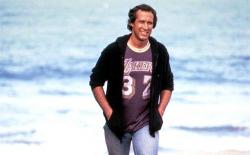Masters of Horror Series: Wes Craven
On August 2nd 1939 the bold, imaginative and innovative genius that is Wes Craven was born in Cleveland, Ohio.
Wes had a strict upbringing by his hyper-religious Mother who was extremely judgmental towards Wes, causing him severe insecurities. Due to the way he was treated by his Mother, Wes was too scared to talk to girls until he went to college and he believes this caused him to marry too young. His first marriage was to Bonnie Broecker with whom he had two children, Jonathan and Jessica. This marriage ended in divorce in 1970.
Prior to becoming a director, Wes was a humanities Professor at Clarkeson University, New York. In 1972 he wrote, directed and edited his first feature film, The Last House on the Left.
Craven admitted in the documentary Inside Deep Throat that he had worked directing many porn movies prior to this to perfect his craft as a director.
In 1982 he married Millicent Eleanor Meyer. Unfortunately this marriage was also doomed. Wes said it ended when he realised it ‘was no longer anything but a sham.’ However the rumour for the end of this marriage was the Meyer had an affair with Sharon Stone.
In 1977 he wrote and directed the cult classic The Hills Have Eyes, and the movie did fairly well when it was released. Wes won ‘Prize of the International Critics’ Jury’ in the Sitges – Catalonian International Film Festival for this movie.
1984 saw the release of another cult classic, A Nightmare on Elm Street with New line Cinema and Craven’s most famous creation, Freddy Krueger. Wes has always had a knack for discovering fresh new talent and he hit the nail on the head here by casting Johnny Depp in his first feature film role. This movie was an instant success and resulted in a whole franchise and a stream of sequels. Wes only worked on parts 1, 3 and 7, the best of the series and, without Wes, New Line just did not seem to get it right.
He was set to direct Beetlejuice but dropped out to work on the third Nightmare movie. Wes said the idea for Nightmare on Elm Street came from a series of stories he had read in the LA Times about young men who were dying in their sleep. The character of Freddy was based on an old man he had seen when he was ten; one night he looked out the window of the apartment he lived in and a drunk man dressed similar to Freddy was looking directly at him and continued to stay there looking at the window for several minutes. This scared him so much that he thought this would be the perfect image for Freddy. It is also rumoured that the name Freddy Krueger comes from a boy who bullied Wes as a child. In 1985 this movie won ‘Critic’s Award’ at the “Avoriaz Fantastic Film Festival”.
Other movies to his credit in the 80s were Swamp Thing, Shocker. The Serpent and the Rainbow and Deadly Friend. He also made a sequel to The Hill have Eyes which he later disowned. Between1985 and 1986 he worked on some Twilight Zone episodes. Then in 1991 came The People under the Stairs. Like many of Wes’ creations this was also based on a story he had seen in the news of parents who lock their kids up and never let them go outside. This was one of Wes’ favourite movies that he worked on and he has talked about the possibility of a remake. In 1992, the Brussels International Festival of Fantasy Film presented him with the Pegasus Audience Award for the thriller The People under the Stairs. Some of Wes’ trademarks in his movies are booby traps and secret passageways due to the fact that he loved that kind of stuff as a kid. In 1992 he also created the short lived TV show Nightmare Café. This saw him reunited with Nightmare on Elm Street star Robert Englund. Unfortunately low ratings led to its cancellation.
In 1995 he directed Vampire in Brooklyn starring Eddie Murphy who also wrote the script. This movie did not receive great reviews and was seen as one of Wes’ poorer efforts but he was about to reach a whole new level of success with the release of Scream in 1996. Craven directed this movie which received Best Movie at the MTV Movie Awards that year. The Gérardmer Film Festival granted him the Grand Prize in ’97 for Scream and he was also nominated for Best Director at the Academy of Science Fiction, Fantasy & Horror Films, USA, in 1997. Scream introduced us to the new slasher character, Ghostface, and was such a success it spawned a trilogy. In 1999 between Scream movies he got offered the opportunity to direct a movie outside the horror/thriller genre called Music of the Heart which saw Meryl Streep earn a nomination for best actress for lead performance.
The noughties saw the return of Freddy in Freddy v’s Jason, where two of the greatest slasher movie characters of the 80s came head to head in a fight to the finish. This movie was directed by Ronnie Yu. This was well received by fans of these two fiends. During this decade Wes also remade some of his most popular movies: The Hills have Eyes, Last House on the Left and Nightmare on Elm Street.
In 2004, Craven married Iya Labunka. She frequently works as a producer on Craven’s films. In 2005 he directed thriller Red Eye which received great praise from publications such as Rolling Stone Magazine and The New York Times. Since 1994’s Wes Craven’s New Nightmare he had not both written and directed a movie and made his return to both roles in 2010 with the movie My Soul to Take. He collaborated with wife Iya Labunka who helped produce the movie. This movie was slated by critics. But in Wes Craven style a comeback was on the cards and it came in the form of the much anticipated 2011 movie Scream 4 which saw Craven once again praised for his directorial talents.
Wes Craven is high on the list of the masters of horror. He knows what makes the audience tick and how to delve into our worst nightmares. When talking about horror movies he has stated: “It’s like boot camp for the psyche. In real life, human beings are packaged in the flimsiest of packages, threatened by real and sometimes horrifying dangers, events like Columbine. But the narrative form puts these fears into a manageable series of events. It gives us a way of thinking rationally about our fears.”
We salute you, sir




Nerd Comments